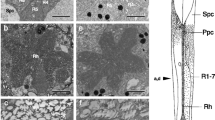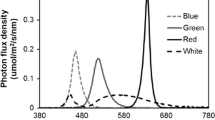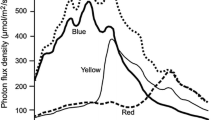Abstract
Regulation of light flux by pupil mechanisms in the UV-sensitive superposition eye of owl-fly Ascalaphus macaronius (Neuroptera) was studied with a fast reflection microspectrophotometric technique. The spectral sensitivity of pupil reaction, which was calculated on the basis of changes of transient amplitude reflection, was almost identical with the one of Deilephila eye. This indicates that in spite of different life styles and spectral sensitivities of photoreceptors, pupil closing is triggered by the same photosensitive structure in both eyes. By measuring the spectra of reflected light from the Ascalaphus eye between 400 and 700 nm after different dark periods following light stimulation, it was established that the restoration of reflection was much faster in the red than in the blue spectral range. Based on this, we propose that two different pupil mechanisms with different spectral absorption characteristics are involved in light-flux regulation. Fast-reacting pupil is probably represented by screening pigment migration in the secondary pigment cells and a slow blue-absorbing system by the activity in primary pigment cells. The importance of two different pupils for the photoregeneration of visual pigment is discussed.
Similar content being viewed by others
Author information
Authors and Affiliations
Additional information
Accepted: 1 October 1998
Rights and permissions
About this article
Cite this article
Stušek, P., Hamdorf, K. Properties of pupil mechanisms in owl-fly Ascalaphus macaronius (Neuroptera). J Comp Physiol A 184, 99–106 (1999). https://doi.org/10.1007/s003590050309
Issue Date:
DOI: https://doi.org/10.1007/s003590050309




